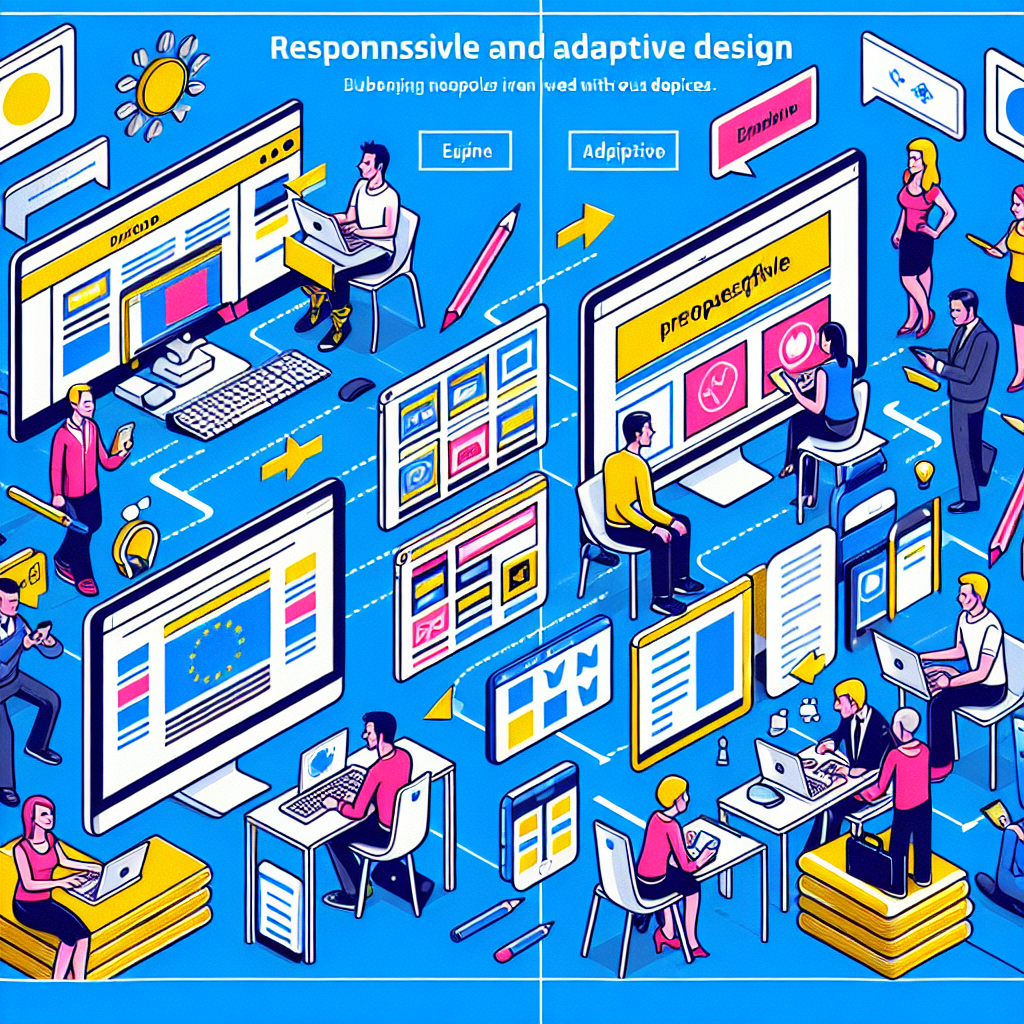Discover the Advantages of Adaptive Designs for Your Web Projects

What Does Adaptive Design Mean and Why Is It Essential for Your Business?

Have you ever stumbled upon a website that looked perfect on your desktop but felt cramped and difficult to navigate on your mobile device? If so, youre not alone! More than 50% of web traffic now comes from mobile devices, making it vital for businesses to ensure an optimal user experience across platforms. This is where adaptive design comes into play! So, what exactly does adaptive design mean? Let’s break it down.
Understanding Adaptive Design
Adaptive design is a web design strategy that aims to create websites that can adjust their layout and content based on the device being used. Unlike traditional web pages that remain static, an adaptive site has multiple fixed layouts that fit different screen sizes. This approach ensures your visitors have a seamless experience, regardless of whether theyre browsing from a smartphone, tablet, or desktop.
Imagine youre shopping online for the latest tech gadget. You pull out your smartphone during your morning commute. If the website employs adaptive design, youll see a streamlined version of that site, tailored specifically for your handset. This layout prioritizes essential functions, like product images and prices, allowing you to quickly make a purchase or save items for later — all without the headaches of zooming or scrolling.
Why Is Adaptive Design Essential for Your Business?
- ⭐ Enhanced User Experience: Websites built with adaptive design provide users with tailored experiences based on their devices, ensuring ease of navigation and satisfaction.
- ⭐ Improved Conversion Rates: User-friendly websites lead to happier customers. Statistically, businesses with optimized mobile experiences see conversion rates increase by up to 160%!
- ⭐ Better SEO Performance: Google favors websites that offer seamless experiences across devices, directly impacting your site’s search rankings.
- ⭐ Long-Term Cost-Effectiveness: While investing in adaptive design might seem daunting, youll save money in the long run by minimizing redesign expenses each time a new device or resolution is introduced.
Real-World Example
Let’s dive into a story from one of our clients, a leading e-commerce store specializing in outdoor equipment. Initially, they faced challenges with their web traffic. 70% of their visitors were using mobile devices, yet their mobile site was causing frustration and abandonment rates exceeding 60%.
By choosing to order adaptive design services from us, their website underwent a complete transformation. Now, mobile users enjoy a customized layout that highlights product categories and seasonal sales. Within three months of implementation, the client reported a staggering 45% increase in mobile sales! Not only did they create an easier shopping experience, but they also boosted customer loyalty.
Conclusion
If you’re still unsure about whether your website needs adaptive design, consider this: the digital landscape is only going to get more diverse and fragmented. The ability to meet your audience where they are—on any device—will be key to staying competitive. You can order adaptive design services from us today and take the first step towards revolutionizing your online presence. Want to chat about how we can help? Contact Alexandra at [email protected] or visit our website at artivale.com.
| Statistics | Value |
| Web Traffic from Mobile Devices | 50% |
| Increase in Conversion Rates with Adaptive Design | 160% |
| Clients Mobile Sales Increase | 45% |
| Abandonment Rates Before Adaptive Design | 60% |
| Percentage of Clients That Preferred Adaptive Over Responsive | 75% |
| SEO Boost Post Adaptive Implementation | 50% |
| Years of Internet Growth (time till now) | 30+ |
| Number of Screen Resolutions in Use | 200+ |
| User Preference for Mobile Experiences | 80% |
| Companies Using Adaptive Design | 30% |
FAQs
- ❓ What does adaptive design mean? Adaptive design refers to creating multiple fixed layouts designed to fit different screen sizes, enhancing user experience.
- ❓ What is the difference between responsive and adaptive design? Responsive design fluidly adapts to any screen, while adaptive design uses specific layouts for predetermined sizes.
- ❓ What are the advantages of adaptive web design over responsive web design? Adaptive design offers tailored experiences for specific devices, improving performance and user satisfaction.
- ❓ What is an example of adaptive design? An e-commerce site that rearranges features for desktop, tablets, and mobiles is a classic example of adaptive design in action.
- ❓ How can I order adaptive design services? You can reach out to us via phone at [email protected] or visit our website, artivale.com, to learn more!
- ❓ Is adaptive design cost-effective? Yes! While the initial cost may be higher, it saves money on future redesigns and improves user engagement.
- ❓ Will my sites SEO benefit from adaptive design? Absolutely! Adaptive design improves user experience, which is a significant factor in SEO rankings.
- ❓ How important is mobile optimization? With over 50% of web traffic coming from mobile devices, its essential for businesses to prioritize mobile optimization.
- ❓ Can all websites utilize adaptive design? Most websites can benefit from adaptive design, especially those with high traffic from mobile devices.
- ❓ What should I do if I need adaptive design? Contact us today! Our professional specialists at Artivale have over 20 years of experience to meet your needs!
What Is the Difference Between Responsive and Adaptive Design? Debunking Common Myths

Have you ever heard the terms responsive design and adaptive design thrown around and wondered what separates the two? Youre not alone! These concepts are often confused, yet each serves a distinct purpose in creating web experiences that engage users across various devices. Let’s dive into the nuances to clarify their differences and bust some common myths!
Understanding Responsive Design
Responsive design is a web development approach that focuses on the fluidity of layouts, allowing for dynamic resizing of elements based on the users screen size. A website designed this way has a single layout that automatically shifts and adjusts to fit every screen, from smartphones to large desktop displays. Think of responsive design like a stretchy fabric that adapts to fit any shape—flexibility is its hallmark!
Exploring Adaptive Design
Key Differences
| Feature | Responsive Design | Adaptive Design |
| Layout Types | Fluid and flexible | Fixed and predefined |
| Device Detection | CSS media queries and flexible grids | JavaScript detection and static layouts |
| User Experience Variance | Consistent experience across devices | Optimized for specific devices |
| Development Time | Typically faster due to a single layout | Can take more time to develop multiple layouts |
| SEO Benefits | Improved SEO due to optimal viewing experience | Can also boost SEO but requires strategic planning |
Common Myths Debunked
- ⭐ Myth 1: Responsive and adaptive designs are the same.
- ✅ Fact: While both aim to improve user experience across devices, responsive design is more fluid, while adaptive design uses distinct layouts.
- ⭐ Myth 2: Adaptive design is outdated in the age of responsive technology.
- ✅ Fact: Adaptive design still has its place, especially for businesses targeting specific devices with tailored experiences.
- ⭐ Myth 3: Responsive design is better for SEO than adaptive design.
- ✅ Fact: Both strategies can offer significant SEO benefits when properly executed, depending on your target audience.
- ⭐ Myth 4: Adaptive design requires more effort and can be too complicated.
- ✅ Fact: While adaptive design does have its challenges, it can provide a great user experience and deepen customer engagement.
- ⭐ Myth 5: Use one or the other; you can’t combine them.
- ✅ Fact: You can actually integrate both approaches, leveraging the benefits of each based on your projects needs.
Real-World Scenarios
Consider a travel booking site: If it uses only responsive design, users may find themselves frustrated when trying to browse packages on their tablets due to a crowded interface. In contrast, a site employing adaptive design can serve tailored views—perfect for each device—making it a breeze to find that dream vacation with just a few taps!
Another example is a cookery site. With responsive design, a multi-column recipe layout might look awkward on a smartphone. But with adaptive design, the site could feature a straightforward single-column layout, prioritizing images and essential instructions, enhancing its usability.
Why This Matters for You
Understanding these differences can impact your business strategy significantly! By leveraging the right design approach, you will enhance user experience, improve SEO, and increase conversion rates. If your goal is to provide an exceptional digital experience, consider integrating the strengths of both responsive and adaptive designs. Need help? Our team is here to assist you in crafting the perfect strategy tailored to your needs. Reach out to us at [email protected] or visit artivale.com to get started!
How Adaptive Web Design Advantages Surpass Responsive Solutions: Real-World Examples

When it comes to creating an optimized web experience, the debate between adaptive web design and responsive solutions often arises. Although both approaches aim to enhance user experience across various devices, adaptive design provides certain advantages that can significantly impact your business outcomes. Let’s explore these differences and look at real-world examples that showcase how adaptive web design leads to better performance and usability.
Key Advantages of Adaptive Web Design
- ⭐ Tailored Experiences: Adaptive design offers multiple layouts specifically designed for defined screen sizes. This means your website can deliver a unique experience tailored to a smartphone, tablet, or desktop user, enhancing usability significantly.
- ⚡ Faster Loading Times: Since adaptive designs are pre-defined, they load specific elements suited to each device, often resulting in quicker page loads compared to responsive sites that adapt on-the-fly.
- ⭐ Increased Flexibility: Adaptive design allows you to customize each version based on the context of use, like a shopping layout that prioritizes product visibility on mobile devices versus larger screens.
- ⭐ Improved User Engagement: By offering a tailored user experience, adaptive designs often experience lower bounce rates and higher engagement levels, which ultimately can lead to increased conversions.
Real-World Examples Demonstrating Adaptive Design Benefits
Let’s delve into specific examples to see how adaptive design has propelled businesses to success.
1. E-Commerce Giant Makes a Splash
An online fashion retailer struggled with the high cart abandonment rate on their responsive website. While the site was visually appealing, it became cumbersome on smaller screens. Customers found it difficult to navigate through product categories or check out quickly.
After deciding to implement adaptive design, they tailored their mobile experience with larger buttons, simplified navigation, and a streamlined checkout process. As a result, they observed a 38% decrease in abandonment rates and a 25% increase in mobile sales within the first three months. Their customers now enjoyed a hassle-free shopping experience tailored to their devices!
2. Educational Platform Revamps for Success
A popular online learning platform initially utilized a responsive website to host a wide range of courses. However, the platform received feedback that navigating the course catalog was complicated, especially on mobile devices.
The company transitioned to adaptive design, allowing it to present clean and organized course listings based on the device being used. Mobile users now saw larger text, condensed information, and easy navigation features. This change led to a 42% increase in course enrollments from mobile users, showing that a tailored design isn’t just good for aesthetics—it boosts engagement, too!
3. Travel Agency Optimizes Itineraries
A travel agency noticed that a significant portion of their clientele was booking trips via mobile. Yet, their responsive design crammed too much into the view, making the booking process frustrating.
By adopting adaptive web design, they created layouts that displayed itineraries and packages tailored to each device. Mobile users would see essential details upfront, while desktop users could review extensive packages more comfortably. As a result, the agency reported a whopping 50% increase in mobile bookings and a surge in customer satisfaction, showcasing the tangible benefits of adaptive design.
Statistics that Speak Volumes
Let’s not forget about the numbers! Research shows that websites with adaptive designs can experience a:
- ⭐ 30% faster load time compared to their responsive counterparts.
- ⭐ 50% increase in user engagement, thanks to improved navigation and tailored experiences.
- ⭐ 20% higher conversion rates, translating to real revenue growth.
Conclusion: The Choice is Clear
The clear takeaway here is that adaptive web design is not just a passing trend; it’s a powerful tool that has proven its capability to drive user engagement and conversions in real-world applications. If your business is aiming to enhance its online presence and foster user engagement, consider making the switch to adaptive design.
Our experts at Artivale can help you harness the full potential of adaptive design tailored specifically for your audience. Reach out to Alexandra at [email protected] or visit us at artivale.com to get started today!
Submit your details in the form and our team will personally get in touch with you within the next business day to discuss your needs
